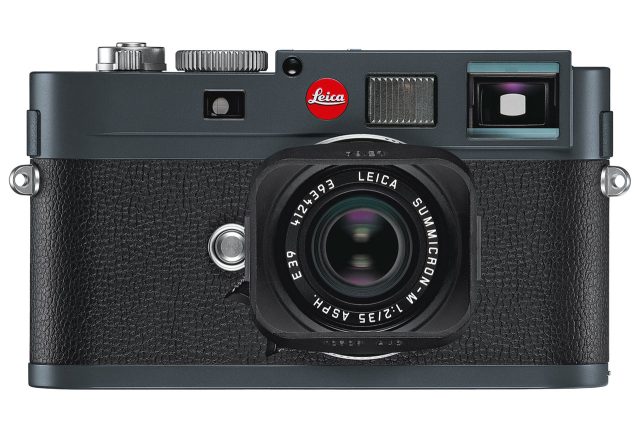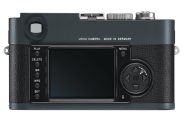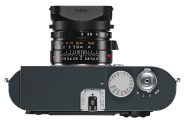Announced
Production status
Order No.
System
Downloads
Leica M system cameras
- Leica M (Typ 240)
- Leica M (Typ 262)
- Leica M Monochrom
- Leica M Monochrom (Typ 246)
- Leica M-A (Typ 127)
- Leica M-D (Typ 262)
- Leica M-E (Typ 220)
- Leica M-E (Typ 240)
- Leica M-P (Typ 240)
- Leica M1
- Leica M10
- Leica M10 Monochrom
- Leica M10-D
- Leica M10-P
- Leica M10-R
- Leica M11
- Leica M11 Monochrom
- Leica M11-P
- Leica M2
- Leica M3
- Leica M4
- Leica M4-2
- Leica M4-P
- Leica M5
- Leica M6
- Leica M6 (Typ 2248)
- Leica M6 Panda
- Leica M6 Titanium
- Leica M6 TTL
- Leica M6J
- Leica M7
- Leica M8
- Leica M8.2
- Leica M9
- Leica M9-P
- Leica MD
- Leica MD-2
- Leica MDa
- Leica MP
- Leica MP Original
Leica M-E (Typ 220)
35mm MF digital rangefinder camera • Discontinued
Specification
| Format: | |
| 35mm full frame | |
Imaging sensor: | 35.8 × 23.9mm CCD sensor |
Resolution: | 5212 × 3472 - 18 MP |
Sensor-shift image stabilization: | - |
| Leica M [27.8mm] | |
| Shutter: | |
Type: | Focal-plane |
Model: | Electronically controlled |
Speeds: | 32 - 1/4000 + B |
| Exposure: | |
Exposure metering: | Through-the-lens (TTL), stop-down |
Exposure modes: | Aperture-priority Auto |
| Manual | |
| Rangefinder and Viewfinder: | |
Rangefinder: | Built-in, combined with viewfinder |
Viewfinder: | Built-in, combined with rangefinder |
Finder magnification: | 0.68x |
Actual rangefinder base: | 69.25mm |
Effective rangefinder base: | 47.09mm |
Bright-line frames: | 35mm & 135mm, 28mm & 90mm, 50mm & 75mm |
Parallax compensation: | Yes |
| Physical characteristics: | |
Weight: | 585g |
Dimensions: | 139x80x37mm |
| Accessories: | |
Body cap: | 14195 |
| 14397 |
Manufacturer description #1
Solms, Germany (September 17, 2012) - Leica Camera presents a new model in the Leica rangefinder system, the Leica M-E. Possessing the high level of technology perfected in the nearly six decades since the M-System’s introduction, the Leica M-E represents the essence of rangefinder photography. Rather than offering all that is technically possible, it is limited to only those functions that create a better image. These essentials include the M-System’s typical rapid manual focusing with the viewfinder/rangefinder and the focusing ring of the lens, as well as the option of selecting automatically determined or manually set shutter speeds. It is the ideal entry-level model for photographers wishing to experience the fascination of M-Photography or require a secondary camera that performs at an optimum level without fail.
Advantages of rangefinder photography include the ability for photographers to become a part of the action and frame whatever they wish to capture in the viewfinder, while still perceiving what is going on outside the viewfinder frame. The crucial moment becomes predictable, and can thus be captured at precisely the right instant. Featuring the proven, high-resolution, 18 MP CCD sensor in full 35 mm format, the Leica M-E offers maximum imaging quality. Perfectly attuned to its role in the extremely compact M-System and the superior performance of M-Lenses, this particular sensor type possesses a high sensitivity to light. These characteristics lead to an unmistakably individual kind of photography.
The Leica M-E’s most distinctive feature is a minimalistic, purist, design statement. The top deck and base plate are discreetly finished in unobtrusive anthracite grey. The application of a new leather trim with enhanced grip characteristics ideally complements the camera’s timeless design.
The Leica M-System portfolio provides perfect tools for capturing a moment discretely, silently and without hesitation, allowing photographers to become a part of the scene. Together with the new Leica M and the Leica M Monochrom, the world’s first digital black and white camera in 35 mm format, the latest digital generation of the Leica M now offers three rangefinder cameras.
Additionally, the Leica M-E package includes the latest version of Leica Adobe Photoshop Lightroom to assist photographers with viewing, editing and managing digital images. The Leica M-E is available now from Leica dealers, including the Leica Store Washington DC.
Manufacturer description #2
With the introduction of the Leica M rangefinder system in 1954, Leica M film cameras became, for many photographers, the perfect tools for capturing the fascination of a moment discreetly, silently, and without hesitation. And naturally in uncompromising quality. The first digital M-Cameras began a new chapter in this long-running success story. Today, the Leica M-E in particular embodies the quintessence of the M-System philosophy: the camera concentrates exclusively on essential photographic functions. Meaning it remains simple and intuitive to the user. At the same time, it is a part of the most compact full-format camera system available and those who use it enjoy access to an array of lenses widely acknowledged as the best in the world. It’s a camera created to let the world discover the fascination of M photography.
Leica cameras were the first widely successful full-frame 35 mm cameras. So it is in homage to this tradition that the digital Leica M-E also features a sensor with the capability of precisely reproducing the full 35 mm frame format of 24 × 36 mm. Thanks to the compact construction allowed by the rangefinder system, it is the most compact full-format system camera of all time. The Leica M-Bayonet mount also represents a long and honored tradition. First constructed in 1954, it still ensures full system compatibility in the present day: that means almost all M-Lenses ever built are compatible for use with the digital Leica M-E. And, just like all other M-Cameras, the Leica M-E is consciously concentrated on photographically essential functions. Manual focusing based on the combined viewfinder and rangefinder principle and an automatic aperture priority exposure mode aid photographers rather than restricting their creative freedom.
The Leica M-E features an 18-megapixel high-resolution CCD sensor in full 35 mm format size. The sensor is perfectly attuned to its role in the very compact M-System and the superior performance of M-Lenses. The special layout of microlenses makes it tolerant of oblique light rays impinging on its surface, and guarantees uniform exposure and maximum sharpness from corner to corner of every image.
It is obvious at first glance that the Leica M-E is a member of the Leica M-System family. Distinctively functional lines lend the camera an absolutely timeless character. After all, the quintessence of the M-System is also expressed by its design. The top deck and baseplate are discreetly and unobtrusively finished in anthracite-gray enamel. The design of its body is intensely focused and expresses clarity, and its leather trim offers a superior grip. The familiar, almost inaudible mechanical sound signature, greatly appreciated by many lovers of Leica cameras, is a constant reminder that this M too is a masterpiece of unparalleled craftsmanship.
Discretion and unobtrusiveness are particular strengths of the M-System. For instance, the shutter action of the Leica M-E is extremely quiet. A sophisticated, almost noiseless motor/gear-train system tensions the shutter for the next exposure – in discreet mode only after the camera is returned to its hiding place, such as under a jacket, and the photographer’s finger is lifted off the release button. At the same time, the combination of camera and lens is more compact than any other full-format camera system: a reason that M-photographers often go unnoticed and simply become a part of the scene.
Everything developed in the evolutionary process of the Leica M-System satisfies a genuine photographic need. This also applies to the Leica M-E: it is a digital rangefinder camera that consciously declines to offer every feature that is technically possible, but rather limits itself to what is essential to photography. These essentials include the M-typical rapid manual focusing with the range- finder/viewfinder via the focusing ring of the lens, but also the option of selecting automatically determined or manually set shutter speeds.


